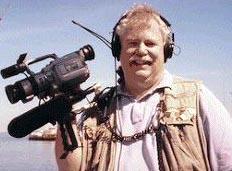|
|
|
|
by Steve Smith All the Support
|
 |
|
In the past few months we've looked at a variety of accessories for miniDV camcorders. Now that we've pretty much filled up our gadget bags, how about we add one more tool that will not even fit into the bag. I'm talking about the mother of all support products: the tripod. When we talk about a tripod for this moving picture business we are talking about two distinct products: the three-legged tripod itself, and the head to which you mount the camcorder. Let's start with the head. To ensure silky-smooth pans and tilts you'll want to use a "fluid-head." As the moniker implies, the head has fluid in it to help dampen the bumps and ensure that smoooooth movement. Many years ago, there was a young engineer by the name of Chad O'Connor. His hobby was making movies of railroads. But, he was frustrated by the jerky pans the "friction-heads" of the day gave him. Why not, he wondered, inject a little viscous hydraulic fluid into the internal workings to make the head work more smoothly. After quite a bit of puttering around, O'Connor came up with the world's first fluid-head. One day, while filming trains at the Glendale railroad station, he noticed a man watching him intently. Eventually, the man approached him and began to ask rather detailed questions about O'Connor's tripod head. The engineer was reluctant to divulge any details to the stranger, but then the man began to talk about how his "cameramen in the field could use a head like this--I'd like to order a few." O'Connor thought the man cheeky and a bit nuts until he introduced himself as Walt Disney. O'Connor made heads for Disney. And that is how fluid-heads were born. These tools tend to be expensive. However, the recent explosion in digital camcorders has seen the introduction of some new, reasonably-priced fluid-head tripods. The one that has caught our attention at Videosmith is the 501 from Manfrotto (sold in the U.S. by Bogen). This is a sleek-looking head with many features of far more expensive units. It will hold cameras weighing up to 13 lbs., yet weighs only 3.5 lbs. itself. It comes with a sliding quick release plate, with both 3/8-16 and 1/4-20 screws, and a locating pin to prevent twisting. The pan handle can be attached to either the left or right side of the head. There are tilt and pan friction knobs for drag adjustment. And, of course, locks for both directions. The performance of the 501 is quite nice--smooth both horizontally and vertically. The Manfrotto 501 is available with two different tripods. The 3211V is a simple telescoping leg support with an adjustable center column. The tripod collapses to just 25", but rises to either 54" or 68" with the column up. The 501 and 3211 combination weighs just under 10 lbs. This rig is a good choice for fast moving situations. The only drawback is the lack of a ball-leveling system (although you can add one). The second tripod option is the 3283B. This is a much heavier-duty unit, with multi-stage legs, a built-in spreader and a ball-leveling base. If nothing else, the 3283B looks more professional. The legs will support up to 33 lbs. (though remember, the 501 head's capacity is just 13 lbs.). Okay. So, how much ya gonna have to pay for this stuff? That's the big and pleasant surprise. The 501/3211V combination retails for a whopping $394. Videosmith sells it for less than $335. That's complete--it even comes with a carrying bag! Best bang for the buck I've seen in a long time. But, let's say you need the sturdier tripod (or want to look even more professional). The 501 with the 3283B runs the bill up to $694 (msrp). That's still pretty doggone affordable. If money is no object, you could fork out $2280 for the Rolls Royce of tripods--the Gitzo Fluide Head with super-light, super-strong carbon fiber legs. It's beautifully-made equipment, but I'm not sure the difference is worth it for general day-in/day-out shooting. I'm impressed with the Manfrotto 501. It is an exceptional value and well worth checking out. To celebrate this Russia-oriented issue, here's my Russian Tripod Story. In 1985 we were in Leningrad (now St. Petersburg) shooting for CBS News. The center of my spreader for my Sachtler tripod broke apart, which meant the legs would not stop spreading--very inconvenient when you have a 35lb. camera sitting on top. I appealed for help to our Soviet TV minder, a melancholy Russian given to quoting Pushkin. I showed Alexi the broken piece. He turned it over in his hands, then turned to me with a glowing smile, "This no problem. I can fix. I have special super glue." The next day, Alexi returned with his "super glue." It was not quite what I expected. Instead of a tube of rocket-science-ultra-fantastic-awesome adhesive, he handed me a can of foul smelling goop that looked as if it had been around since the days of Peter the Great. Not wanting him to lose face (and willing to try anything to get my tripod back in operation) I slopped some of his super glue onto the broken pieces and let them cure overnight. Less than optimistic, I tried the rig the next morning. The joint held for about fifteen seconds then separated, permanently. He was crestfallen. But then reaching into his pocket, he pulled out a small skein of twine and with another glowing smile said, "Try this." I took the twine and wrapped it around the ends of the tripod legs to make an ersatz spreader. It worked pretty well, and to my surprise, sufficed for the rest of the month we were in the USSR. I still have the ill-repaired spreader center, with lumps of Alexi's goop clinging to it. And I always carry a spare center, just in case... |
|